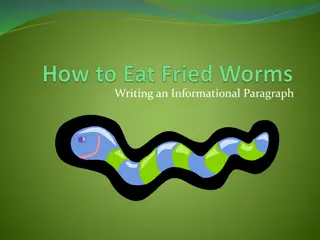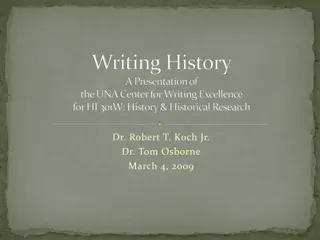
Mastering Essay Introductions and Paragraph Structure
Learn the art of crafting impactful essay introductions and structuring paragraphs effectively to engage readers and present your ideas clearly. Understand the funneling process, the importance of each paragraph, and how to convey your research with precision.
Download Presentation

Please find below an Image/Link to download the presentation.
The content on the website is provided AS IS for your information and personal use only. It may not be sold, licensed, or shared on other websites without obtaining consent from the author. If you encounter any issues during the download, it is possible that the publisher has removed the file from their server.
You are allowed to download the files provided on this website for personal or commercial use, subject to the condition that they are used lawfully. All files are the property of their respective owners.
The content on the website is provided AS IS for your information and personal use only. It may not be sold, licensed, or shared on other websites without obtaining consent from the author.
E N D
Presentation Transcript
Writing Introductions & Paragraph Structuring
Introductions are the most important part of your essay. Scientific writing is up-front. You introduction should give a clear overview of what is being delivered in your paper. Introductions The introduction is the part of the paper that is most likely to be read.
Structure of the Intro The introduction should follow a funneling process. It should be clear what the hypothesis or research objectives are. There is no room for waffle. Every sentence matters. A general academic should be able to follow along.
Intro: First Paragraph The first paragraph should tackle the context of the big picture problem A first sentence that gives an impactful object of study. Explain the knowns of this problem. End the first paragraph on the problem/unknown that your paper will tackle. If your paper starts in the minutia, then readers may not realize the importance and applicability of your work. Or you might bore them.
Second+ Paragraph Now funnel down to your specific research area Process of deductive research Explain your more specific parameters i.e. more specific disease, chemical interaction, region, etc. Keep doing this process until you have a workable hypothesis/research project.
Show how you go about addressing the unknown in your research (The "Here we" paragraph) Here we Paragraph Add more paragraphs if it is a complex study, but simplifying is always better. Make sure you cover key methods or approaches. Depending on the journal, you may also need to include results (or add a short results paragraph)
Structure of Paragraph Point Evidence Analysis P E A
Point Start each paragraph with a clear topic sentence Everything in the paragraph will directly link to this point. Therefore, you may need to edit your topic sentence as you complete your paragraph. Or you should recognize that your paragraph should be split if you make another point. Preferably, you should not cite in your first sentence as it is a point that YOU are making (this is often broken though).
Evidence After you make your point, you need to back it up with evidence to support that point. This can take a number of forms such as examples This is where most of your citations should be. For example Greenfield et al states that We know this because
Analysis End your paragraph by explicitly stating to the reader what was important. Lead them to what you are seeing Make sure the analysis transitions into the next point. Therefore, Thus, This shows that This is effective because
First Paragraph: Big picture In free ranging populations, hosts are commonly co-infected with more than one parasite species. Co-infecting parasites may interact, and mounting evidence suggests that these interactions are critical to understanding the dynamics of host and parasite communities in the wild (Telfer et al., 2008; Ezenwa and Jolles, 2011). Co-infecting parasites have been shown to alter infection risk (Telfer et al., 2010), infection intensity (Pedersen and Antonovics, 2013), and the fitness consequences of infection (Graham et al., 2005). For example, competition between coinfecting parasites may result in decreased infection severity (Dobson and Barnes, 1995); alternatively, suppression of the host immune response by one parasite may increase the likelihood or severity of infection with another parasite (Su et al., 2005; Bandilla et al., 2006). These studies highlight the importance of parasite interactions, yet our ability to predict the dynamics and host fitness consequences of interacting parasites in the wild remains limited. The topic sentence sets up that this paper is interested in the broad topic of co-infection Then evidence is provided on the relevant knowns on co- infection. The analysis is that coinfection is important and then ends on what an unknown
2nd : Funneling the problem Gastrointestinal (GI) parasites are ubiquitous, taxonomically diverse, and cause mortality, or declines in condition and/or reproduction in a variety of livestock (Larsson et al., 2006; Larsson et al., 2011; Thumbi et al., 2013) and wildlife systems (Gulland, 1992; Stien et al., 2002; Pedersen and Greives, 2008). GI parasites can affect their hosts by directly consuming host resources or indirectly by damaging intestinal function (Stewart and Penzhorn, 2004), altering host behavior (Adelman and Martin, 2009), or disrupting the control of co-infecting parasites (Jolles et al., 2008). The magnitude of these direct and indirect effects, and thus their impact on host fitness, is likely to be dependent on the host immune response (e.g. Adelman et al., 2013). Seasonal resource availability is directly related to the host immune response (Demas, 2004; Altizer et al., 2006) and mediates the intensity of infection (Ezenwa, 2004) and host survival (Pedersen and Greives, 2008). In young animals or sub-optimal environmental conditions, hosts may prioritize growth and self-maintenance over immunity (Eraud et al., 2008; Cotter et al., 2011), potentially resulting in seasonal increases in infection severity. Thus, predicting the consequences of parasites and parasite interactions on host fitness (Thumbi et al., 2014) and disease dynamics (Telfer et al., 2010) may require detailed information on the effects of GI parasites on individual condition and fitness across different environmental (season) and host demographic (age, sex) conditions. This topic sentence funnels from coinfection to a more specific interaction of GI parasites. Then evidence is provided on the relevant knowns on co- infection. The analysis states that this evidence then can be used to answer the unknown of the first paragraph and why this is important.
3rd: More funneling The topic sentence then introduces the specific parasites to be studied. However, doesn t say why these parasites are important Interactions between coccidia and nematode parasites, two common components of GI parasite communities, have been well documented in laboratory systems (Stewart et al., 1980; Rose et al., 1994, reviewed in Cox, 2001). Nematode parasites are a diverse group of macroparasitic (extracellular parasites) worms and coccidia are highly immunogenic protozoan microparasites (intracellular parasites). Coccidia replicate within the epithelial cells of the intestinal mucosa, often resulting in physical damage and activation of the mucosal immune system (Stewart and Penzhorn, 2004). The host immune system likely plays an important role in the interactions between nematodes and coccidia because intracellular and extracellular parasites invoke opposite and cross-regulating immune responses (Morel and Oriss, 1998). As a result, hosts may have difficulty simultaneously mounting a strong response to co-infection by intracellular and extracellular parasites, leading to increased disease severity in co-infected animals (Graham, 2008; Jolles et al., 2008). Parasites are also often indirectly linked through host resources, which could result in either facilitation or competition (Randall et al., 2013). For parasites within the gastrointestinal tract, resource mediated interactions are reported more frequently than immune mediated interactions (Griffiths et al., 2014), although the relative strength and consequences of these interactions requires further investigation. Thus, interactions between coccidia and nematodes are likely because of their shared resources and location within the host gastrointestinal tract and the opposing immune responses they invoke. Then evidence is provided on the relevant knowns on co- infection. The analysis is that coinfection is important and then ends on what an unknown This is a new point that should have been integrated. This evidence and analysis should be integrated above.
Here we paragraph This study explores how coccidia nematode co-infection influences the prevalence, egg/oocyst counts (a proxy for parasite intensity), and fitness costs of infection in African buffalo (Syncerus caffer), a host commonly co-infected with both parasites (Penzhorn, 2000). Like most ruminants, buffalo body condition (Ezenwa et al., 2009; Parker et al., 2009) and some immune responses (Beechler et al., 2012) vary seasonally with resource quality. Buffalo body condition mirrors resource quality at a 2 4 month lag (based on fecal nitrogen; Ryan et al., 2012) and thus, buffalo reach peak condition in the late wet season/early dry season and are in poorest condition in the late dry season/early wet season (Caron et al., 2003). Further, both coccidia and nematodes have a fecal-oral transmission route that results in seasonal variation in exposure (Horak et al., 2004; Stewart and Penzhorn, 2004). Exposure, interactions among parasites, and mortality may all influence the distribution of parasites among hosts, or parasite aggregation (Wilson et al., 2002). Because host immune responses and parasite exposure vary over time, we predict that the strength parasite interactions, and thus the fitness costs of co-infection, will be exacerbated during times when animals are in poor condition. If host mortality is dose-dependent, then reduced parasite aggregation may be indicative of mortality in highly infected individuals. We use a 5-year dataset on seasonal health and infection patterns of 1375 African buffalo to establish seasonal patterns of infection and co-infection. We then examine three proxies for host fitness host pregnancy, host body condition, and parasite aggregation to evaluate how co-infection and season interact to influence host fitness. The topic sentence ends on the specific topic this paper will cover Core evidence that backs the main topic. The analysis here signposts the most important features of the study to the reader including the hypothesis, methods, and important variables.






















